explore building blocks
Components, Concepts, Protocols,...
Power System Reference Architecture
High level reference architecture of a power systempower-system ref-architecture
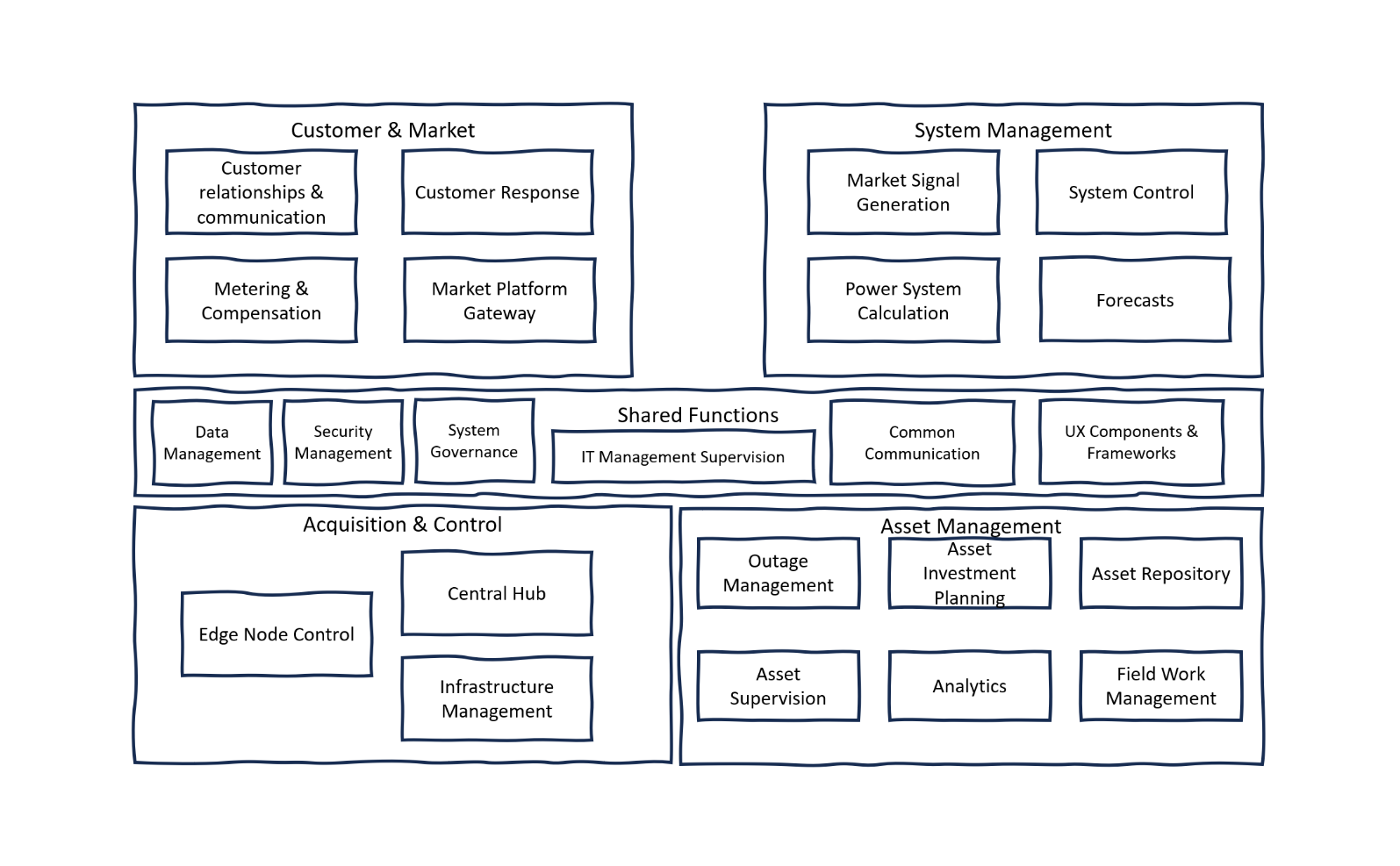
Description
Overall, this architecture aims to provide a structured approach to managing the complex and interrelated components of a modern power system. It highlights the need for integration and communication across various domains to ensure efficient and reliable power delivery.
Sub-components:
Customer & Market: This area focuses on the interactions between the power system and its customers, as well as the market mechanisms. It includes managing relationships and communication with customers, understanding customer responses to market dynamics and power system changes, monitoring energy usage for accurate billing and compensation, and managing the market platform gateway, which covers aspects like bidding, pricing, and trading of energy. This comprehensive approach integrates customer interaction, response analysis, financial transactions, and market operations to ensure efficient energy market functioning.
System Management: This section relates to the overall management of the power system. It includes the generation of market signals based on activities such as price changes, control mechanisms for managing the power system's operation, calculations related to power flow and load distribution, and predicting future system needs, including demand and generation capacity. These elements are crucial for maintaining the balance and efficiency of the power system, ensuring stable operations, and planning for future requirements.
Shared Functions: These are services that support multiple aspects of the power system platform. It covers data management, involving the storage, processing, and analysis of data from the power system; security management, focusing on the cybersecurity and physical security of the infrastructure; system governance, which includes the rules and policies governing system operation; IT management supervision, overseeing the IT components supporting the system; common communication, referring to standard communication protocols and infrastructure; and UX components & frameworks, which are the user experience aspects, including interfaces for operators and customers. These elements are crucial for the efficient, secure, and user-friendly operation of power systems.
Acquisition & Control: This concerns the gathering and management of data and control signals throughout the power system. It includes Edge Node Control, which involves managing control points at the edges of the grid such as substations and smart meters; the Central Hub, which serves as the main control center for data acquisition and issuing control commands; and Infrastructure Management, which deals with overseeing the physical components of the power system infrastructure. These components are integral to maintaining a stable and efficient power grid, ensuring smooth operation and effective response to various demands and conditions within the power system.
Asset Management: This area involves managing the physical and digital assets of the power system. It includes Outage Management, which covers everything from detecting to restoring power outages; Asset Supervision, focusing on monitoring the condition and performance of power system assets; Asset Investment Planning, which involves strategic planning for future investments in assets; Analytics, used for analyzing data to enhance asset management decisions; an Asset Repository, for storing detailed information about assets, including specifications and history; and Field Work Management, which organizes and tracks maintenance and repair work on system assets. These components are essential for ensuring the reliability and longevity of power system assets and efficiently managing outages and maintenance activities.
System Management
Managing the physical flow and balance of a power system.power-system ref-architecture
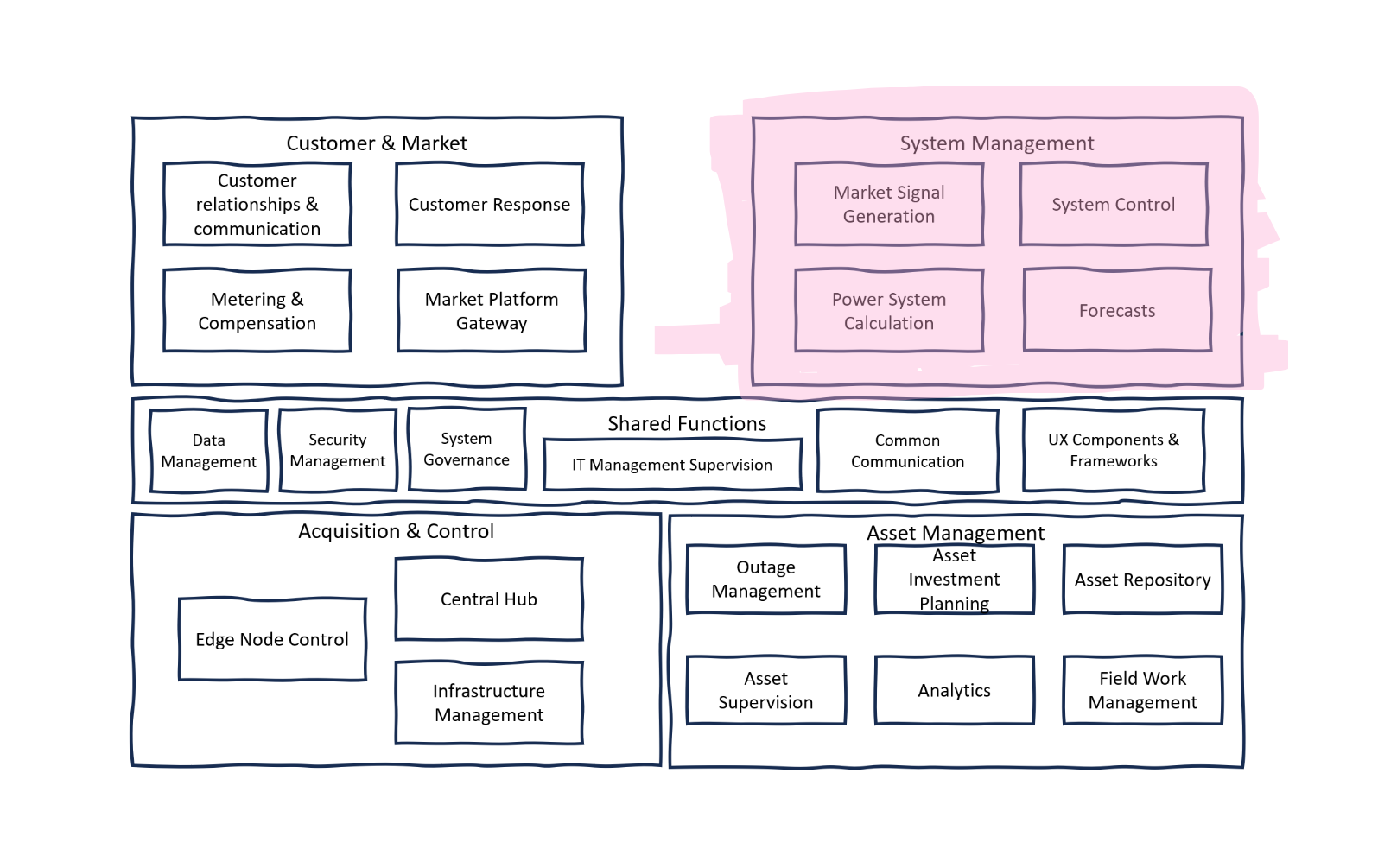
Description
System Management section of the power system's reference architecture integrates critical operational processes that ensure the stable and efficient functioning of the power grid. It comprises a range of activities from the generation of market signals to control mechanisms, complex calculations, and future forecasting. This comprehensive framework is designed to maintain system integrity, optimize resource distribution, and anticipate future requirements to make informed decisions for grid management and investment.
Sub-components:
Market Signal Generation: is a vital part of the system management that deals with the creation of indicators that reflect the current state of energy supply and demand across different regions, including cross-border capacities. It includes assessing the sufficiency of resources to meet demand (adequacy assessment) and establishing mechanisms for balancing the grid. It also involves the organization of aggregated services that can offer collective resources or demand reduction to the grid as a single entity, enhancing the grid’s flexibility and stability.
System Control: component encompasses the operational aspects of the power system, such as remote operation, centralized automation, and the establishment of schedules. It ensures that all system operations are conducted efficiently and reliably. This includes maintaining power quality and system stability, as well as configuring autonomous functions to respond to system conditions. The control mechanisms in this section are critical for real-time management of the power grid.
Power System Calculation: is responsible for all the mathematical modeling and computational work necessary to understand and predict the behavior of the power system. It includes state estimation to provide a reliable picture of the grid's current state, as well as simulation tools for planning. Static and dynamic calculations help to understand the potential impacts of different scenarios, and dispatch/adequacy calculations ensure that the power system can meet demand. Security analysis is also a key aspect, assessing the system’s resilience to potential threats or failures.
Forecasts: module anticipates future system needs, such as area demands, renewable energy generation from resources like solar and wind, and the balance of local sites. It also predicts market behaviors, including international and local market prices, which are essential for strategic planning and investment. Forecasting capabilities enable the power system to adapt to upcoming trends and changes, ensuring long-term sustainability and efficiency.
Customer and Market
Covering all the functionalitites related to the customer and interaction with markets and other thrid partiespower-system ref-architecture
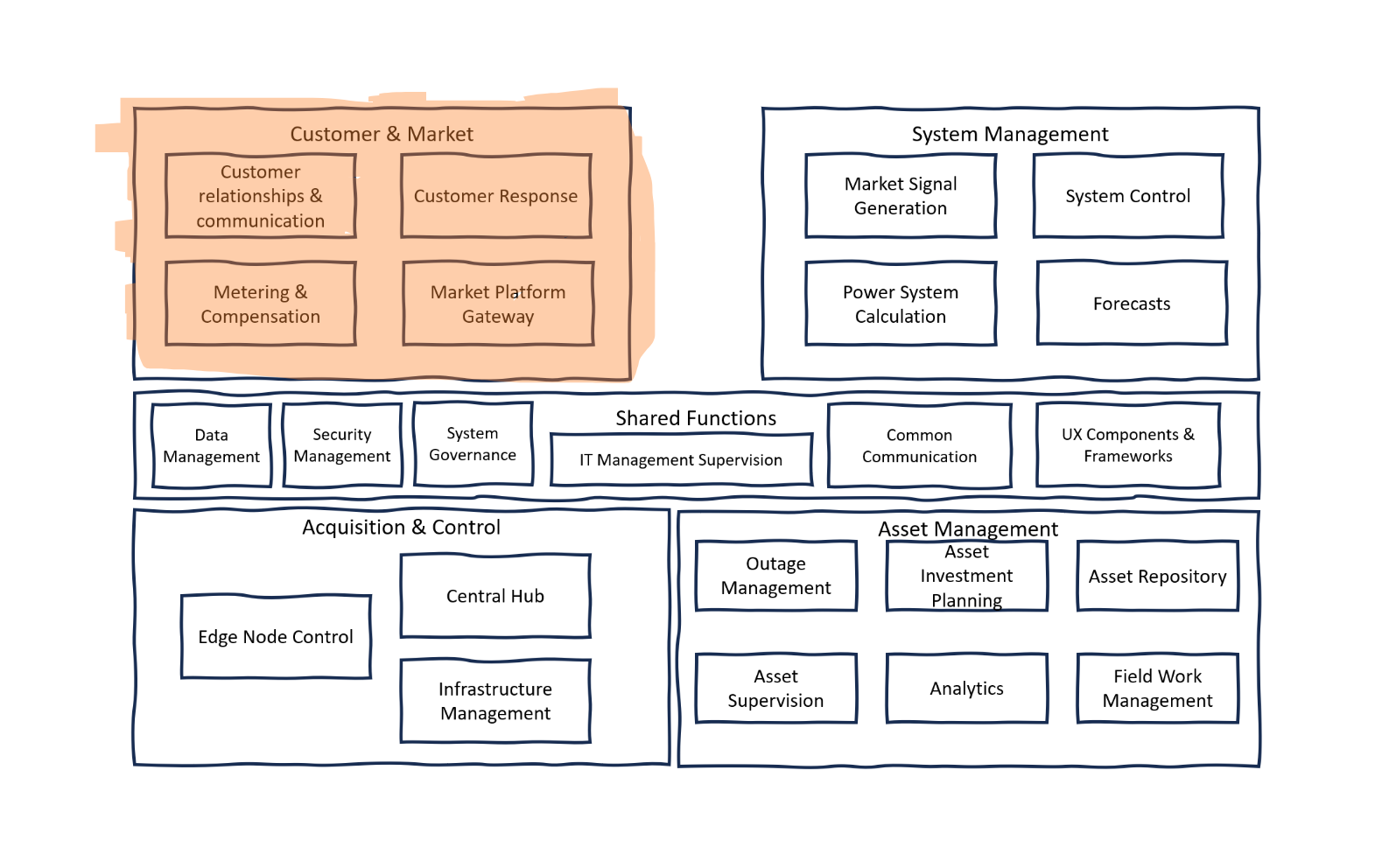
Description
The Customer and Market section of the power system's reference architecture represents the interface between the electricity providers and their customers, as well as the market mechanisms that govern energy trading. This segment is essential for managing the complex interactions and transactions between various stakeholders, including utility companies, consumers, and market operators. It ensures that the needs and preferences of customers are met while maintaining efficient market operations. The diagram outlines the structure and flow of information, highlighting the importance of customer engagement and market facilitation in the power system.
Sub-components:
Customer Relationship and Communications: is all about the acquisition of customers, the design of systems and pricing, and the management of ongoing communications. It includes managing notifications and critical communications, especially during energy crises, which is essential for maintaining customer trust and satisfaction. The component also considers the user experience with customer applications, ensuring that interfaces are intuitive and effective. Contracts and consent management are integral parts of this component, ensuring that all engagements with the customer are legally compliant and respect privacy.
Metering and Compensation: focuses on the accurate measurement of energy usage and the subsequent billing and compensation. Metering is the foundation of this component, as it provides the data necessary for transparent and fair billing. Compensation and settlement mechanisms are in place to ensure that any energy fed back into the grid by customers, perhaps through renewable energy sources, is appropriately compensated. This aspect of the architecture is critical for financial fairness and accuracy in the power system.
Customer Respons: deals with how customers interact with and respond to the power system. It includes technologies such as smart ledgers and contracts, which facilitate dynamic and automated interactions between the customer and the service provider. This component also takes into account customer preferences, allowing for a more personalized and responsive service. This adaptability can enhance demand response programs, where customers modify their energy usage in response to real-time market signals.
Market Platform Gateway: serves as the interface for all market operations, including the power exchange, capacity platform, and balancing market. It's where energy trading occurs, with mechanisms for ensuring the availability of energy, managing cross-border capacity, and providing various services. This gateway is vital for the operational efficiency of the power market, facilitating transactions and ensuring that supply meets demand in both the short and long term.
Asset Management
Covering the digital functionalities required to manage your assets.power-system ref-architecture
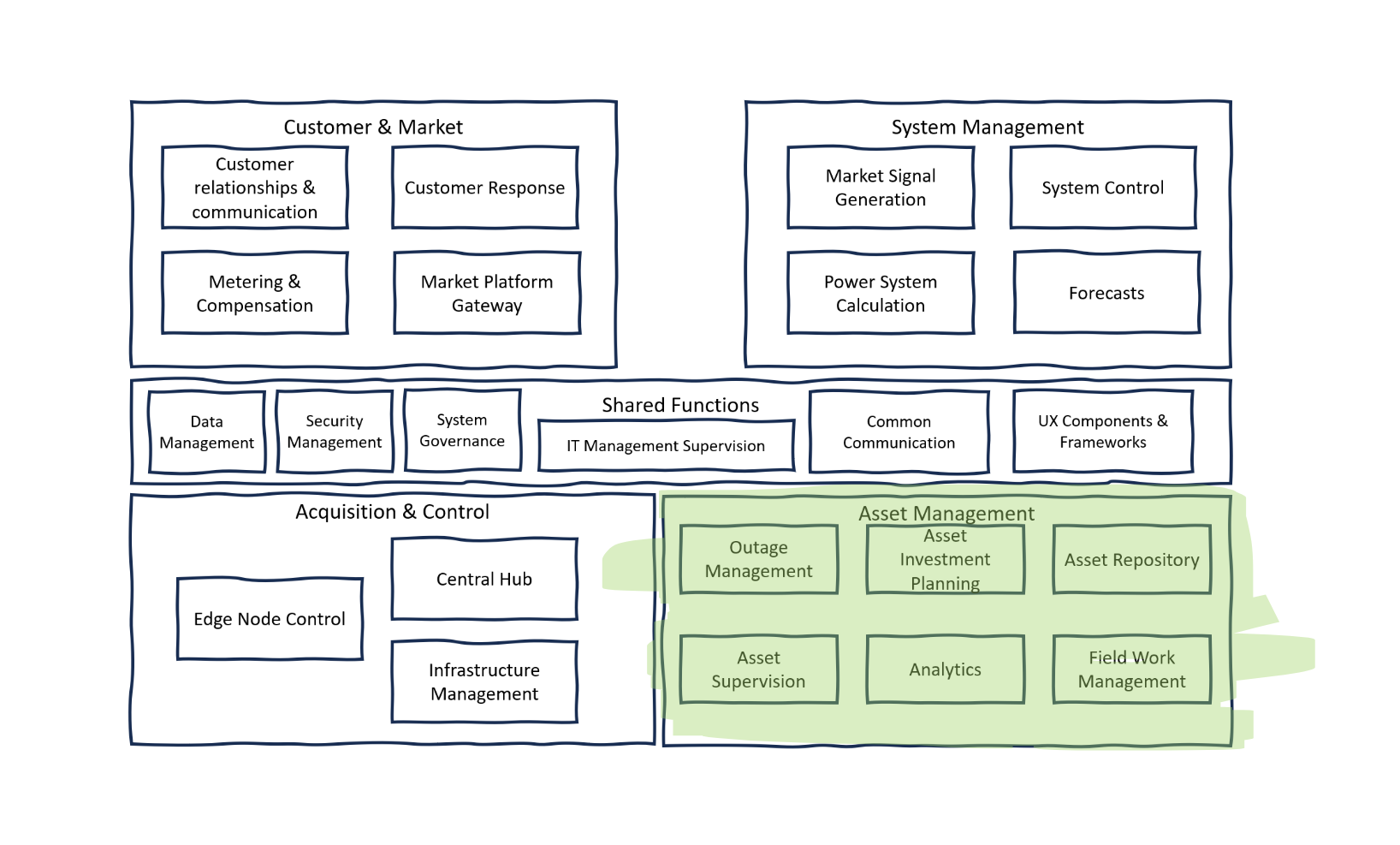
Description
Asset Management within a power system's reference architecture is a comprehensive approach that ensures all physical and digital assets operate optimally throughout their lifecycle. It spans from outage management and investment planning to supervision, analytics, and field operations. This segment of the architecture is integral to the sustainable operation of the power grid, ensuring that assets are well-maintained, efficiently utilized, and strategically enhanced or replaced over time.
Sub-components:
Outage Management: is focused on efficiently addressing power outages with a systematic approach. This includes ticketing systems for issue tracking, programming, and planning for outages, as well as assessing the impact on customers. Effective coordination and management of outages, especially distributed outages, are crucial for minimizing downtime and ensuring prompt restoration of services. This component is key to maintaining customer satisfaction and the reliability of the power supply.
Asset Investment Planning: ensures that investments in power system assets are made strategically. This involves managing policies for renewable energy integration, setting overarching investment policies, and handling the financial aspects of asset procurement and deployment. The goal is to align investment decisions with the long-term objectives of sustainability, reliability, and financial viability, taking into account the evolving energy landscape and regulatory environment.
Asset Supervision: encompasses the real-time monitoring of asset performance, including the analysis of logs and data collected from the assets. It ensures that all assets are performing as expected and identifies any issues that may require attention. This component is also responsible for the overall planning of asset utilization and lifecycle management, ensuring that each asset is used effectively and maintained properly from acquisition to retirement.
Analytics: in Asset Management involves the application of various data analysis techniques to enhance asset performance and predict future maintenance needs. It ranges from basic health index calculations to sophisticated predictive analytics, leveraging digital twin technology, deep learning, and simulations. These analytical processes are essential for proactive asset management, allowing for data-driven decision-making that can extend asset life and optimize performance.
Field Work Management: is concerned with the organization and execution of maintenance and repair operations in the field. It enforces safety rules, manages team planning and scheduling, and oversees the supply chain to ensure that field operations are conducted safely and efficiently. This component plays a crucial role in keeping the power system operational and ensuring that the workforce is productive and well-coordinated.
Asset Repository: serves as a centralized database for all information related to power equipment and digital infrastructure. It includes detailed records of power equipment, configuration tools, and settings, which are essential for efficient asset management. This repository allows for quick retrieval of specifications, maintenance histories, and configuration details, facilitating better decision-making and faster response times for maintenance and troubleshooting. It acts as the knowledge base for the asset management system, supporting other components by providing the necessary data for informed asset supervision, analytics, and fieldwork management.
Acquisition and Control
Covering the digitial capabilities to monitor and control our assets.power-system ref-architecture
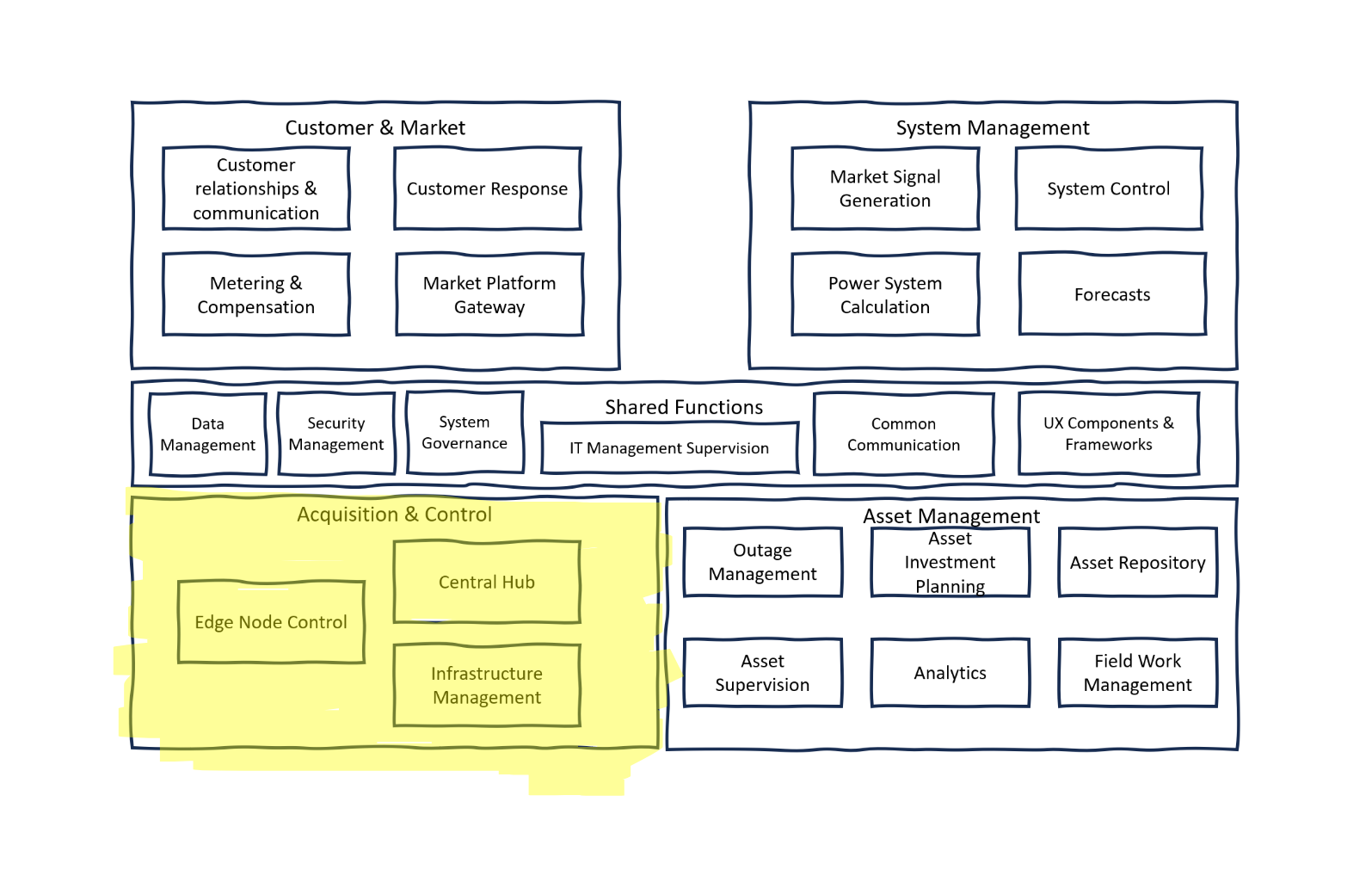
Description
The Acquisition and Control section in the power system architecture focuses on the collection and management of data and the control of power system operations. This is where the physical state of the power system is monitored, decisions are made, and actions are taken to maintain system stability, efficiency, and reliability. This includes managing both less-critical and critical equipment, ensuring that all components communicate effectively, and that control actions are timely and accurate.
Sub-components:
Edge Node Control: is the first line of the acquisition and control system, managing the control points at the edges of the grid, such as substations and smart meters. It handles protocol management, local automations, and ensures synchronization and balance within the power system. This involves monitoring and control of the equipment, management of frequency and storage, and overseeing power quality. It also includes the aggregation and protection of distributed or virtualized equipment, recording failures, and managing demand response and outages.
Central Hub: is the command center for the acquisition and control section. It oversees the protocol conversion, data acquisition, and ensures cross-device and vendor compatibility. It supports data encryption and key management to maintain the integrity and security of the control systems. The hub is essential for the centralized management of the power grid, ensuring that data from various nodes is collected, processed, and used effectively to make system-wide decisions.
Infrastructure Management: involves the remote supervision and administration of physical and digital power system assets. This includes managing remote equipment and nodes, configuring system settings, and handling the commissioning and installation of new assets. This component ensures that all pieces of the power system are correctly set up, maintained, and updated to respond to the grid's operational demands and to support the long-term strategic goals of the power system.
Shared Functions
Covering the digitial functionalities that are required by each of category.power-system ref-architecture
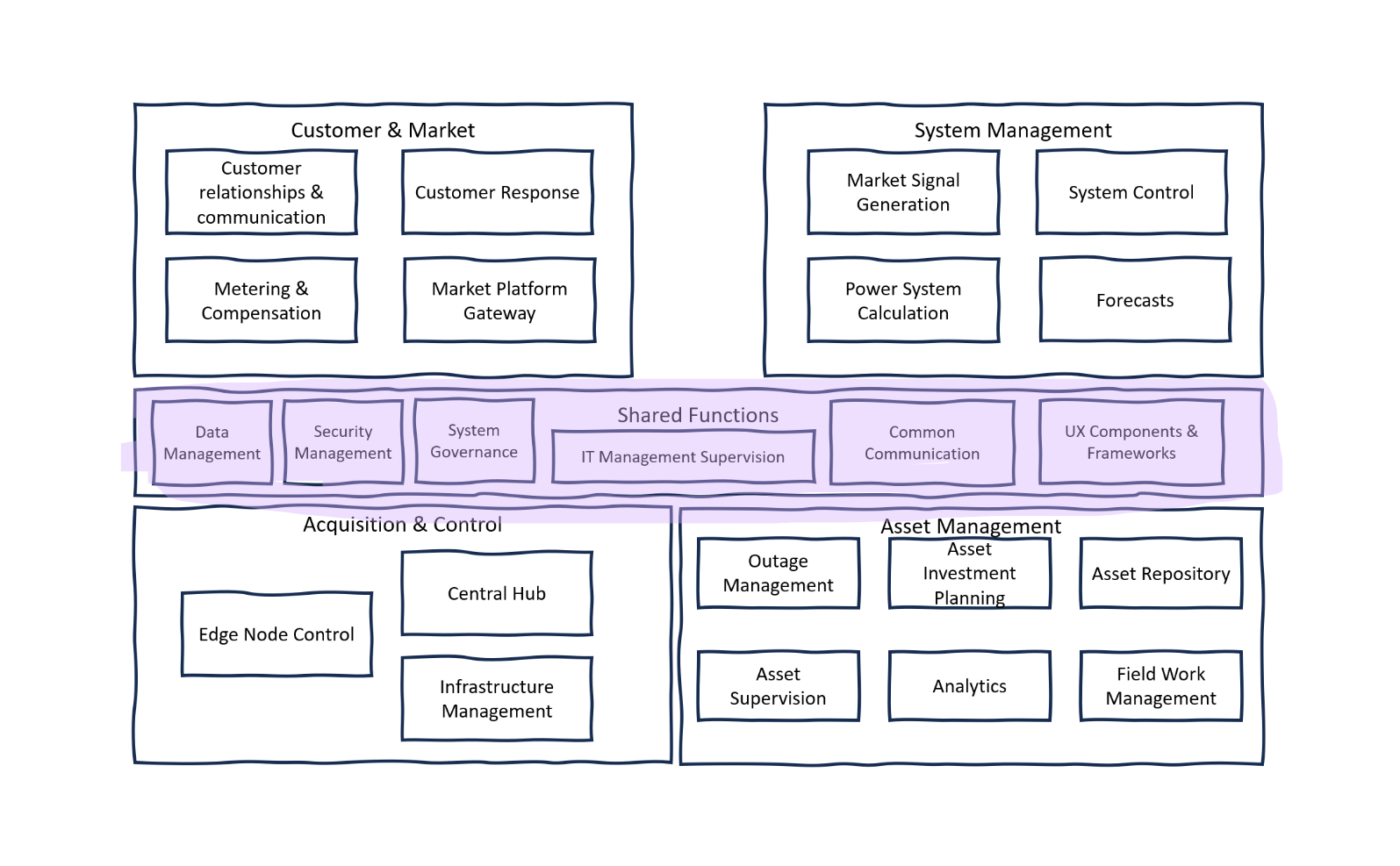
Description
The Shared Functions in the reference architecture of a power system encapsulate the essential services and processes that support various aspects of the system's operation. They provide the foundational capabilities that are utilized across different system components, ensuring that the power system operates efficiently, securely, and in compliance with regulatory standards. These functions are crucial for the seamless integration and management of the system's diverse elements, from data handling to user experience.
Sub-components:
Data Management: is the backbone of the Shared Functions, focusing on the handling of all system data. This includes long-term storage solutions that ensure data integrity over time, message queuing services that manage the flow of data between system components, and data validation processes that ensure the accuracy and reliability of the data used across the system.
Security Management: encompasses cybersecurity measures to protect the system from digital threats and privacy management to safeguard sensitive information. This function is critical in an era where cyber threats are increasingly sophisticated, requiring robust security protocols to protect infrastructure and customer data.
System Governance: is concerned with the overarching management and regulatory compliance of the power system. It includes self-registering components that can autonomously identify themselves within the system and self-healing mechanisms that allow the system to recover from faults automatically. Governance aligns system operations with regulatory standards and best practices.
IT Management Supervision: oversees the technical aspects of system operation, such as network administration and service administration, ensuring that all IT components are functioning correctly and efficiently. It also includes threat monitoring, which is vital for the early detection and mitigation of potential IT-related risks.
Common Communication and Media: function ensures that there are standardized communication protocols and infrastructure across the system, which is crucial during emergency and crisis management situations. It also includes a messaging queuing service and directory for efficient communication routing.
The Electrical Power Lifecycle
5 main steps in electrical power lifecycle, from generation to consumptionpower-system concept
Description
The electricity power lifecycle, from generation to consumption, involves several key stages. Here's an overview:
Sub-components:
Generation: Electricity generation occurs in power plants using a variety of energy sources. Fossil fuels such as coal, natural gas, and oil are commonly used to heat water and produce steam, which drives turbines connected to generators. In nuclear power plants, nuclear fission serves a similar purpose. Renewable energy sources, including solar panels, wind turbines, hydroelectric facilities, and geothermal plants, are also increasingly used. Each method involves converting a different form of energy into electrical energy.
Transmission: Following generation, electricity is transmitted over long distances via high-voltage transmission lines. To minimize energy loss during this process, the voltage is increased with step-up transformers. These transmission networks, which can span across states or regions, are essential for delivering electricity from power plants to the areas where it is needed.
Distribution: Once electricity reaches its destination area, it enters the distribution stage. Here, step-down transformers reduce the voltage to safer levels suitable for residential and commercial use. The electricity then travels through lower voltage distribution lines and is managed by distribution substations that ensure its efficient flow to various sectors such as homes, businesses, and industries.
Consumption: The consumption stage is where electricity is utilized by end-users. This includes households, commercial buildings, industrial facilities, and other entities that use electricity for a myriad of purposes like lighting, heating, operating appliances, and machinery. The amount of electricity used by these end-users is typically measured by meters.
Feedback and Grid Management: Modern electricity grids incorporate advanced technologies for feedback and grid management. Smart grids use technology to monitor grid performance and manage the flow of electricity, adapting to changes in demand and supply. This includes demand response strategies, which involve adjusting consumer electricity usage, especially during peak hours, to maintain balance and efficiency in the electricity grid. These innovations are crucial for enhancing the grid's reliability and efficiency.
State Estimation
Establish a statistical state of a given real system (measured with unperfect noisy sensors) that is coherent with a physically representative model.power-system system-management
What?
State Estimation is a computational process used in power systems to determine the most accurate possible picture of the electrical grid's current state.
This involves estimating various state variables, like voltages and power flows, across different nodes and lines in the grid.
Why?
Data Incompleteness: In a vast power grid, it's impractical to measure every variable directly due to logistical and technological limitations.
Measurement Errors: The measurements that are available often come with noise and errors, as sensors and data acquisition systems are not perfect.
Grid Reliability and Efficiency: Accurate state estimation is crucial for the reliable and efficient operation of the power grid. It helps in real-time monitoring, decision-making for load management, and preventing potential failures.
How?
Data Collection: It starts by collecting data from sensors spread across the grid, like voltage and current measurements.
Grid Modeling: The power grid is represented by a mathematical model, typically nonlinear equations based on physical laws like Kirchhoff’s laws.
Statistical Analysis in State Estimation involves feeding noisy and incomplete data into a statistical process, using techniques like Least Squares Estimation to reconcile these measurements with the grid model by minimizing differences between them. For nonlinear models, an iterative refinement process is often necessary to fine-tune the estimation, ensuring the results accurately reflect the grid's current state.
Error Analysis: The process includes evaluating the reliability of the estimated state, considering the quality and quantity of the input data.
